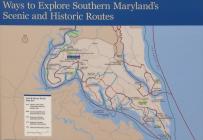Inscription
Captain John Smith Chesapeake National Historic Trail
This unique trail is designed for you to experience by boat. It is America's first waterway national historic trail and includes more than 3,000 miles explored by Captain John Smith.
The route is marked at several sites on the water by special buoys that are part of the Chesapeake Bay Interpretive Buoy System (CBIBS). Accessible by cell phone or internet, these buoys transmit date that include historical information related to Captain John Smith's explorations.
Visit www.nps.gov/cajo
Religious Freedom National Scenic Byway
Automobile is the best way to experience this byway. You can explore various sites--churches, homes, parks, and museums--to learn about the very first attempt in American to introduce religious toleration and the separation of church from state. If you would like to tour any of the churches, we recommend contacting their administrative offices before you visit.
Visit www.bit.ly/rfsbyway
Star-Spangled Banner National Historic Trail
Southern Maryland was an attractive target for British raids during the War of 1812. Along the trail are the sites of the largest naval engagements in Maryland waters. Follow the route of British warships as they sailed to and from their attacks on Washington and Baltimore. Explore historic sites such as Sotterley Plantation, which was raided in 1814 when at least 48 enslaved people sought freedom on British ships.
Visit www.nps.gov/stsp
Potomac Heritage National Scenic Trail
This evolving trail network is a portal into the region's history, culture, and ecology. As the metropolitan area expands, hiking, bicycling, paddling, horseback riding, and related outdoor recreation activities provide you with opportunities for intimate connections with the river, its tributaries, and the region's distinctive landscapes.
Visit www.nps.gov/pohe
Discover more at
www.DestinationSouthernMaryland.com
National Park Service
U.S. Department of the Interior
This project was funded in part by the National Park Service
This project has been financed in part with state funds from the Maryland Heritages Areas Authority, an instrumentality of the State of Maryland. However, the contents and opinions do not necessarily reflect views or policies of the Maryland Heritage Areas Authority.
This unique trail is designed for you to experience by boat. It is America's first waterway national historic trail and includes more than 3,000 miles explored by Captain John Smith.
The route is marked at several sites on the water by special buoys that are part of the Chesapeake Bay Interpretive Buoy System (CBIBS). Accessible by cell phone or internet, these buoys transmit date that include historical information related to Captain John Smith's explorations.
Visit www.nps.gov/cajo
Religious Freedom National Scenic Byway
Automobile is the best way to experience this byway. You can explore various sites--churches, homes, parks, and museums--to learn about the very first attempt in American to introduce religious toleration and the separation of church from state. If you would like to tour any of the churches, we recommend contacting their administrative offices before you visit.
Visit www.bit.ly/rfsbyway
Star-Spangled Banner National Historic Trail
Southern Maryland was an attractive target for British raids during the War of 1812. Along the trail are the sites of the largest naval engagements in Maryland waters. Follow the route of British warships as they sailed to and from their attacks on Washington and Baltimore. Explore historic sites such as Sotterley Plantation, which was raided in 1814 when at least 48 enslaved people sought freedom on British ships.
Visit www.nps.gov/stsp
Potomac Heritage National Scenic Trail
This evolving trail network is a portal into the region's history, culture, and ecology. As the metropolitan area expands, hiking, bicycling, paddling, horseback riding, and related outdoor recreation activities provide you with opportunities for intimate connections with the river, its tributaries, and the region's distinctive landscapes.
Visit www.nps.gov/pohe
Discover more at
www.DestinationSouthernMaryland.com
National Park Service
U.S. Department of the Interior
This project was funded in part by the National Park Service
This project has been financed in part with state funds from the Maryland Heritages Areas Authority, an instrumentality of the State of Maryland. However, the contents and opinions do not necessarily reflect views or policies of the Maryland Heritage Areas Authority.
Details
Pictures
Photo Credits: [1] NATIONAL PARK SERVICE, THOMAS STONE NATIONAL HISTORIC SITE [2] NATIONAL PARK SERVICE, THOMAS STONE NATIONAL HISTORIC SITE [3] NATIONAL PARK SERVICE, THOMAS STONE NATIONAL HISTORIC SITE [4] NATIONAL PARK SERVICE, THOMAS STONE NATIONAL HISTORIC SITE [5] NATIONAL PARK SERVICE, THOMAS STONE NATIONAL HISTORIC SITE [6] NATIONAL PARK SERVICE, THOMAS STONE NATIONAL HISTORIC SITE
Locationbig map
| Directions Information | Enter Thomas Stone National Historic Site. Turn left at the T-intersection. Stop at Visitor Center. |
|---|---|
| Location Description | Marker is located to the right of the front door of the Visitor Center. |
| UTM (WGS84 Datum) | 18S E 322542 N 4266618 |
| Decimal Degrees | 38.53028333, -77.03586667 |
| Degrees and Decimal Minutes | N 38° 31.817', W 77° 2.152' |
| Degrees, Minutes and Seconds | 38° 31' 49.02" N, 77° 2' 9.12" W |
| Driving Directions | Google Maps |
| Area Code(s) | 301, 240 |
| Can be seen from road? | No |
| Is marker in the median? | No |
| Which side of the road? | Marker is on the right when traveling North |
| Closest Postal Address | At or near 6370 Crain Hwy, La Plata MD 20646, US |
| Alternative Maps | Google Maps, MapQuest, Bing Maps, Yahoo Maps, MSR Maps, OpenCycleMap, MyTopo Maps, OpenStreetMap |
Is this marker missing? Are the coordinates wrong? Do you have additional information that you would like to share with us? If so, check in.
Nearby Markersshow on map
Discover Thomas Stone National Historic Site
Discover Thomas Stone National Historic Site
Discover Southern Maryland's Amazing Stories of Exploration, Hope, and Courage
Ways to Explore Southern Maryland's Scenic and Historic Routes
Discover Southern Maryland's Amazing Stories of Exploration, Hope, and Courage
Welcome to Haberdeventure!
Thomas Stone
Rose Hill
Rose Hill
Port Tobacco






Comments 0 comments